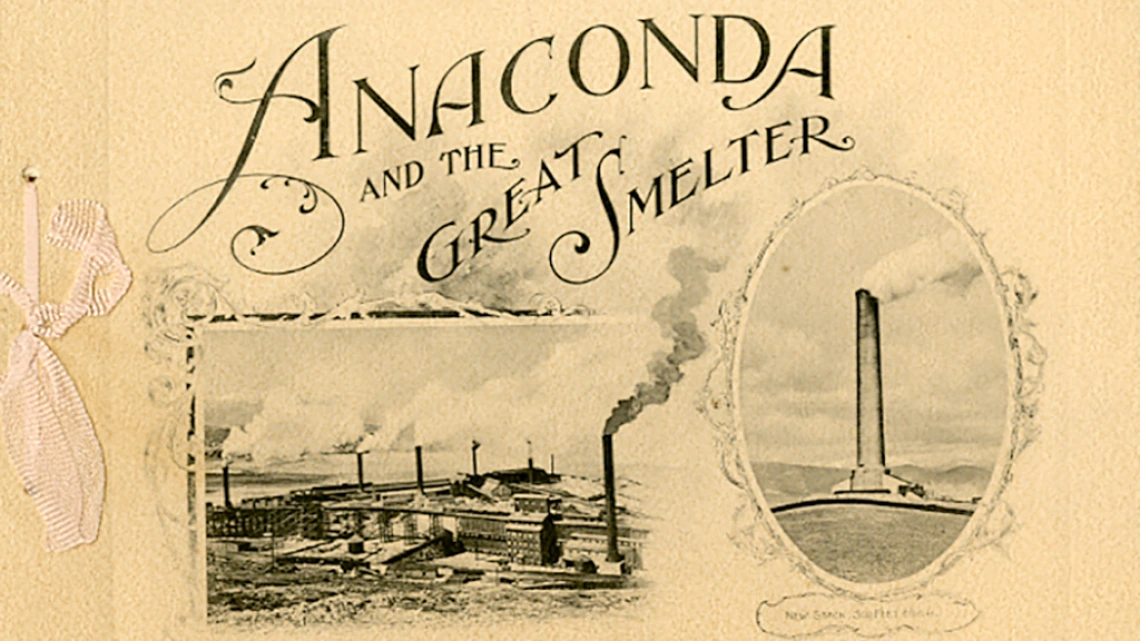Edward Mathewson papers

Published in 1903, this book contains several photographs of the Anaconda Mine in Montana, where Edward Mathewson worked for many years. The book includes views of the mine, mining machinery, stacks, the smelter, other mining areas and machines, views of lodgings used by the workers, as well as a few notable buildings in the town of Anaconda (Box 2, Folder 10).
Collection dates: 1864 to 1948
The Edward Mathewson Papers contain the work of Canadian metallurgist Edward Mathewson, known for his work with Anaconda Copper Mining Company and later, his service as a professor at the University of Arizona. The collection includes five series pertaining to Mathewson’s personal and work life. Series I consists of mining papers and materials, including work related manuscripts, mining papers, mining machinery patent designs, books, periodicals, scrapbooks, and blueprints with a date range 1891-1950. Some of the papers within this series include mining correspondence and letters, papers from publications that Mathewson worked on, as well as some material from his work as a professor at the University of Arizona in Tucson, Arizona.
Series II includes printed and negative photographs that Mathewson took while working in different mines across the country as well as tourist photographs taken while on vacation by himself or with his family. Earlier photographs are taken in 1877 with the later of the photos being taken in 1922. There are both loose and rolled photographs as well as a series of scrapbooks and family photo albums (1877-1931).
In the third series, there are various forms of correspondence including a large collection of postcards from different countries. Some of these postcards have correspondence on them while others remain unused and were collected as Mathewson traveled Europe. There are also several mining photographs, taken by Mathewson, that were used as postcards. Mathewson’s letters include several compiled collections of letters he wrote to his wife, Alice Barry. Also included are letters to other members of the family, personal correspondence to friends and colleagues, and University of Arizona related correspondence as acting professor. A subseries also includes diaries and journals written by both Edward and Alice, as wells as a few cashbooks that tracked the family finances.
In Series IV there are printed materials from 1900-1950, including many newspapers. Some of the clippings are about mining, but many of the clippings are about the opera—one of Edward’s personal pleasures. There are also a few large landscape prints. Series V includes various ephemera related to Mathewson’s life. Items include certificates and degrees he was awarded, plaques from scholarly associations, and a small collection of pins and medallions.
Edward Payson Mathewson was born on October 16, 1894 in Montreal Canada to parents James Adams and Amelia Seabury (Black) Mathewson. He was raised with an Episcopalian upbringing and focused on his studies as a child. Interested in mining, he enrolled at McGill University, a public university in Montreal, and received his Bachelor of Science degree in mining in 1885.
Post-graduation, Mathewson moved to Pueblo Colorado in 1886 began working as an assayer at Pueblo Smelting and Refining Company, where he rose to the position of general superintendent of the plant by 1889. It was early on in his career as an assayer that Mathewson met Alice Barry, whom he was infatuated with instantly. The couple married in 1890 and throughout his career, Mathewson continued to write about his wife profusely. During the couple’s early years together Mathewson took on the job of superintendent at Pueblo (Colorado) Smelting and Refining Company (1889-1897). Next, he joined Guggenheim’s Sons technical staff in 1897 and followed this with becoming the superintendent and manager at Perth Amboy, New Jersey, Monterey, Mexico, and Antofagasta, Chile, until 1902. He remained under the employ of Anaconda Copper Mining Company (1902-1916) while also staying on as the manager of Washoe Reduction Works of company at Anaconda (1903-1916).
As a metallurgist, Mathewson received several other honors and awards during his career. He received gold medals from the Institution of Mining and Metallurgy in London (1911) as well as from the Mining and Metallurgical Society of America (1917).
Mathewson soon returned to Canada and worked as the general manager of British American Nickel Corporation, Ltd., in Toronto from 1916-1918. After this excursion, he became the director and consultant metallurgist at American Smelting and Refining Company in New York (1918-1919). He remained a consultant metallurgist since 1919. From 1919-1926 he took on work as a private consultant.
Still interested in pursuing further degrees, Mathewson completed further coursework and received his Doctorate of Science from Colorado School of Mines in 1920. Two years later, he received his Doctor of Laws degree. He was an active member of the American Institute Mining and Metallurgical Engineers, including a stint as President in 1923. He also was a notable Fellow of the American Association for the Advancement of Science. During his time in Tucson, he was part of the Old Pueblo Club.
In 1926, Mathewson came to the University of Arizona in Tucson to teach mining administration and metallurgical courses. He continued with this career until his retirement in 1942 and passed away a few years later on July 13, 1948.
Mathewson, a dedicated scholar, never forgot to strengthen the bonds of family at home. He and Alice had four daughters and a son: Alice Seabury (Mistress E. V. Graybeal), Grace (Mistress North Carolina Streit), Gertrude (Mistress Arkansas Nolin), Mary Elizabeth (Mistress E. F. Bissantz), and Edward Payson.
A collection guide explains what's in a collection. New to using our collections? Learn how to use a collection guide.
Collection guideAccess this collection
Visit us in person to access materials from this collection. Our materials are one-of-a-kind and require special care, so they can’t be checked out or taken home.
How to cite
Learn how to cite and use materials from Special Collections in your research.
